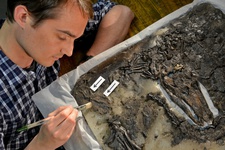
Download
Kontakt
Manuela Bank-Zillmann
Telefon: +49 345 55-21004
Telefax: +49 345 55-27404
presse@uni-halle.de
Universitätsplatz 8/9
06108 Halle
Login für Redakteure
Fossil crocodilian with eggs likely shows crocodile ancestors were good mothers 45 million years ago

Modern crocodilian mothers guard their eggs and young, but without any direct fossil evidence, scientists could only hypothesize that ancient crocodiles were also good mothers. This fossil shows the behavior likely goes back at least 45 million years into the fossil record. "This is easily the most remarkable fossil crocodile I have ever seen", said lead author Dr. Alex Hastings of Martin-Luther-Universität Halle-Wittenberg, "the fossil tells us a lot about growth and reproduction, which you very rarely get the opportunity to study in the fossil record".
The good mother crocodilian belongs to an extinct species called Diplocynodon darwini, named after the renowned evolutionary thinker Charles Darwin. Despite being able to produce offspring, the 1-meter female (a little over 3 ft) was not done growing, shown by the fusion of vertebrae in the fossil. Fusion of vertebrae is commonly used to judge how old dinosaurs and other fossil crocodiles were when they died, meaning this little mother crocodilian gives new information that will be helpful in researching other extinct forms of ancient life.
In 1932, the excavators took very detailed notes including the position and identity of each fossil taken from the small area of the brown coal mine. From these records, the researchers were able to rule out volcanism, flooding, and drought as likely causes of death. The eggs were not hatched or scavenged and there was no sign of injury on the adult. The large amount of animal bodies collected from one layer of coal may instead show a mass die-off that could have happened during a short 'cold snap', even despite the warm climate. A similar situation occurred in 2010 in the Everglades of Florida (USA) where many animals that were adapted for a warm climate, including crocodiles, died quickly during the unusually cold weather of a 2-week 'cold snap'.
Another possibility is that the mother crocodilian instead died of a condition called dystocia, where an egg blocks the canal and prevents further egg-laying. This condition is very rare in modern crocodiles, but takes days or longer to lead to the death of the mother. This means that under either scenario, the mother evidently stayed with her eggs until death, showing a strong maternal instinct in this fossil crocodilian species.
Although excavation at the mine ended in the 1990s and the area has since been turned into a recreational lake, fossils from this site are still leading to new discoveries.
Alexander K. Hastings: "Rare In Situ Preservation of Adult Crocodylian with Eggs from the Middle Eocene of Geiseltal, Germany", Palaios, June 2015, DOI: 10.2110/palo.2014.062
Website: http://dx.doi.org/10.2110/palo.2014.062
